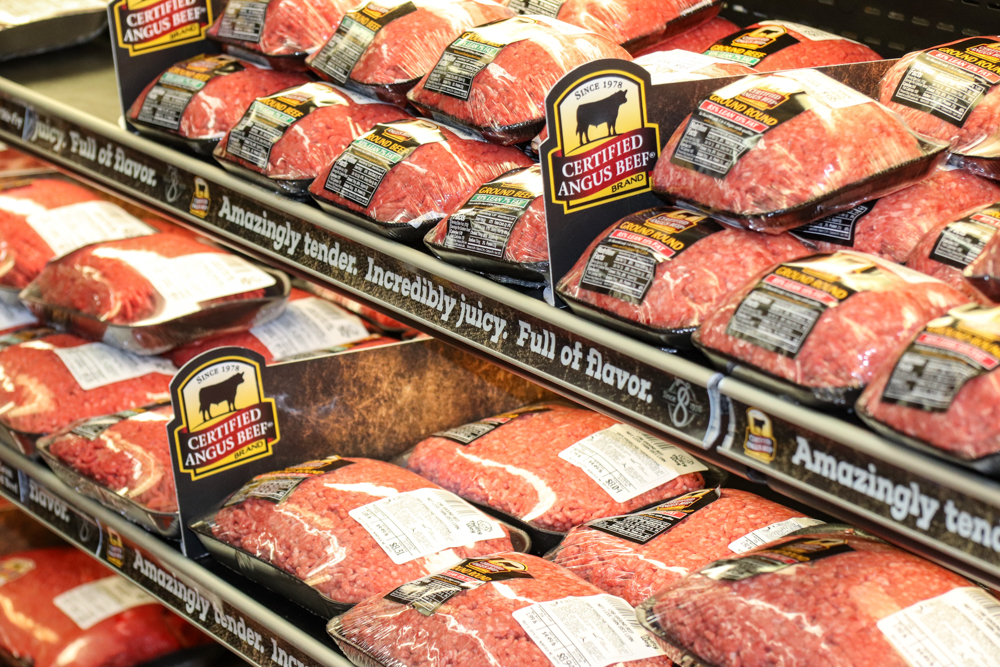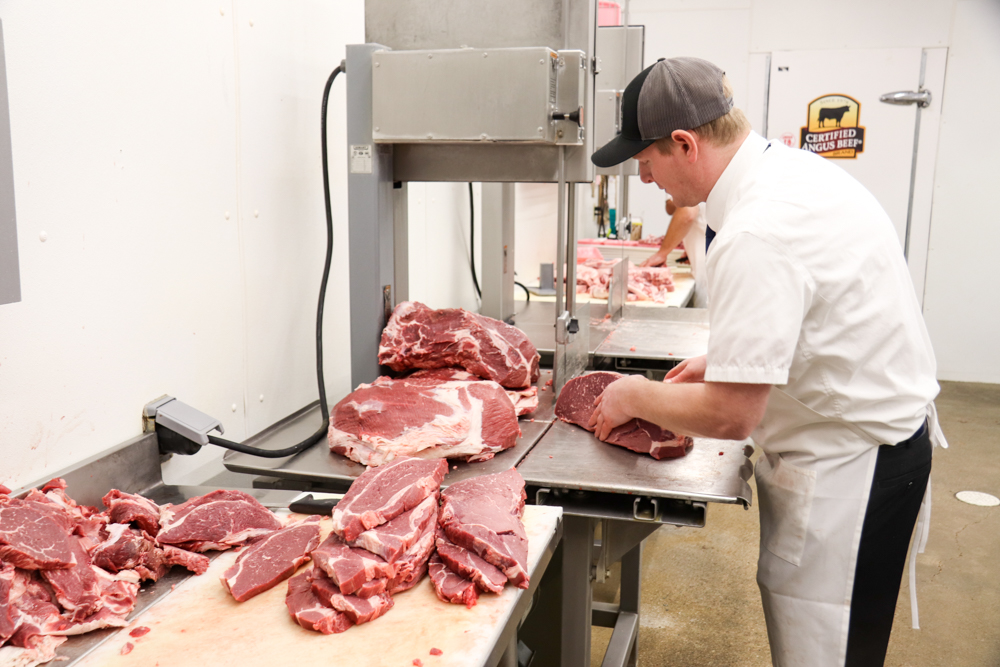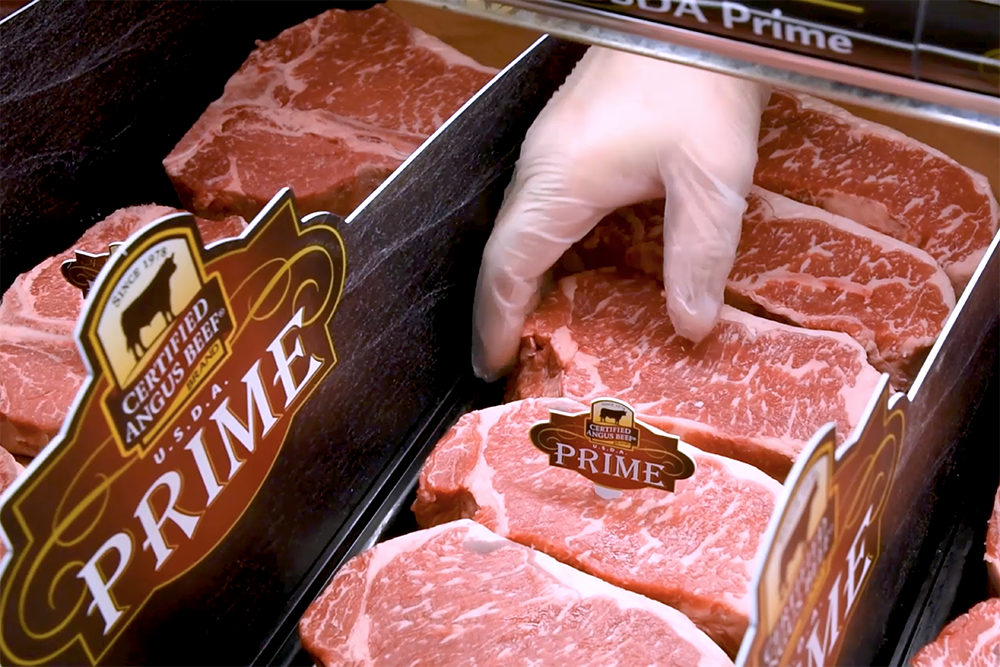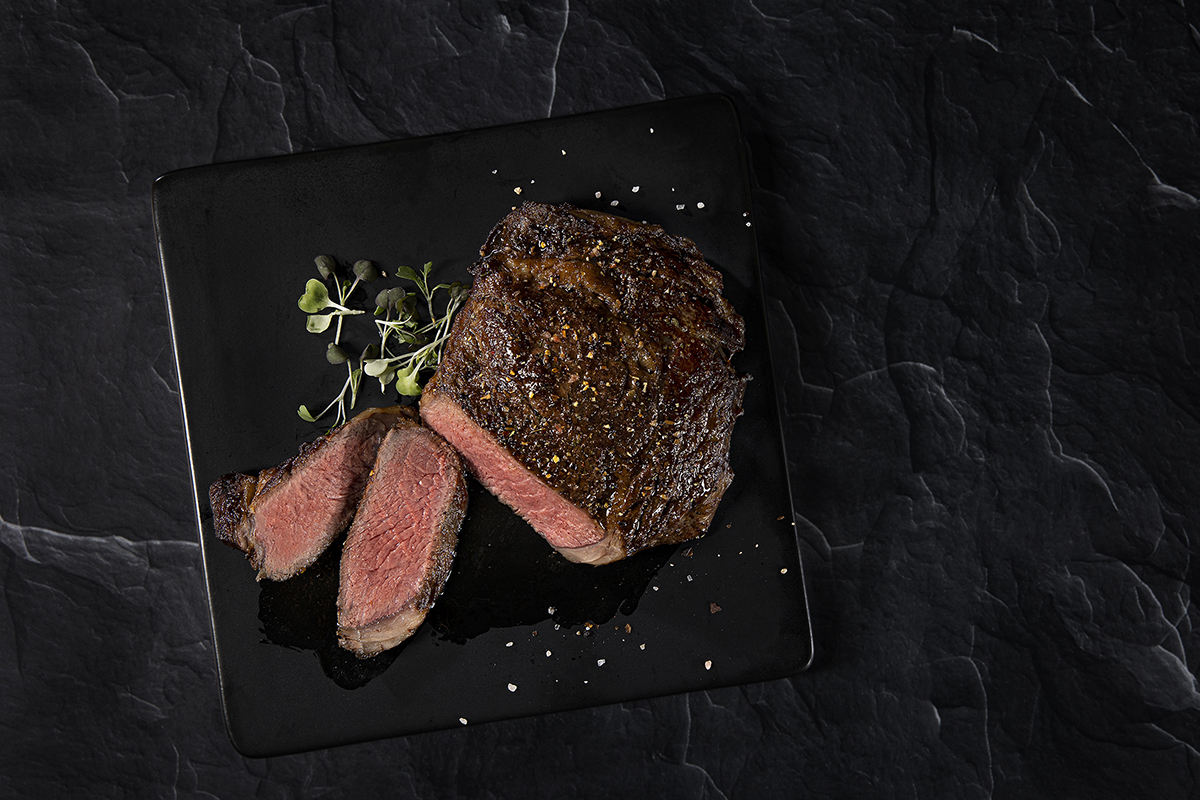CAB VOLUME LEADING DIVISION SELLS MORE OF EACH QUALIFIER
By: Abbie Burnett
2021
Two million, four hundred and thirty-two thousand. That’s how many cattle it took to supply the 608 million pounds (lb.) of Certified Angus Beef® (CAB®) cuts sold by 3,000 retail partners in fiscal 2020.
As the heavyweight champ in brand volume, retail accounts for 55% of total pounds sold. Brand sales have surpassed the supply of USDA Select beef because CAB retail licensees are partners in the mission, says David O’Diam, CAB vice president of retail.
“We provide opportunity and resources that move pounds and get shoppers to the meat case. Simply carrying USDA Choice and Select doesn’t give you access marketing support,” O’Diam says.
VOLUME MOVER
The retail strategy starts with differentiation in the meat department. No successful grocery store is without one. The package and canned goods in the middle aisles represent little revenue potential. It’s the perimeter of the store—supplying the center of the plate—that generates retail profits. Getting customers to buy meat at a store practically guarantees the rest of their grocery shopping at the same location.
The meat director is responsible for a tremendous amount of profitability of that store, O’Diam says. “If meat’s losing, they’re losing.”
Everyone sells soup, but not everyone sells CAB. And if retail is the ace of brand sales, then their ad features are “king, queen, and probably jack in regards to volume,” he says.
How much volume?
“You put a high-end, hot-priced item on that front page—especially for a holiday—and we could have retailers looking at 70 truckloads of product,” O’Diam says.
Just for one item, for one week.
This past October, Weis Markets’ director of meat ran a “buy-one, get-two-free” ground beef sale for three days that generated two weeks’ worth of business. “It’s all an investment,” says Doug Becker at the 196-store Mid-Atlantic chain based in Sunbury, Pa.
“We don’t run ads for a one-and-done, never have,” Becker says. “I feel very confident that if they try the beef, they’re going to come back just because of the quality.”
Running a $2.99/lb. sale on CAB brisket may seem to “cost him a fortune,” he notes. That kind of promotion is called a “loss leader,” but he knows once customers come in, they will buy from the rest of the meat case.
However, meat buying and selling can’t just happen on a whim.
Supply must be assured. Cattle have to be bought and processed. There’s packaging and inventory management and all the steps in between.

A retailer who books 10,000 cases of ribeyes for Christmas, reserves the ribs of 25,000 qualifying cattle. Memorial Day and Fourth of July holidays each move more than 2 million lb. of ground beef in a long weekend.
CAB has a team of executive account managers (EAMs), who work within assigned regions to spot opportunities and provide creative ideas.
“Retailers tend to go with what they know, repeating year over year,” O’Diam says. “They’re always measuring against the previous year, so they’re looking at margin, gross and sales simultaneously.”
If a retailer ran a hot $1.99/lb. ground beef ad some week last year and wants to go with rib eyes this year, comparisons won’t be so easy. Dollar income will be sizeable, but sales volume will be way down. That’s why O’Diam says the same features tend to run the same weeks every year.
“That circular is going to drive upwards of 70% of the retailer’s overall volume,” he says. “We work tooth and nail to make certain we are getting Certified Angus Beef in the circular.”
If commodity beef is in the circular, an EAM might suggest showing the small price increase it would take for a step up to CAB, to attract quality-minded customers and gain exposure.
“In order to own that front-page feature, we have to be the beef of choice in that retailer’s mind,” O’Diam says.
HOLISTIC MINDSET
EAMs keep a pulse on the market, letting retailers know when they spot a deal. That takes advantage of opportunities as they arise, O’Diam says. An account manager might see a dip in the price of shoulder clods and call a retailer with ideas: “Hey, I know you’re probably looking at chuck this week; what do you think about moving that to clods? We could do maybe some in-store featuring.”
That’s one example of why retail leads CAB sales. That division has the holistic advantage of considering virtually every beef cut sold in the U.S.
“We don’t want to be just a middle-meat brand,” O’Diam says. “That would make it challenging not only for our packer side, but also for producers to get incentivized from only a premium on middle meat. We want to be able to merchandise those end meats, and that’s specifically done at retail.”
Becker says if he has quality beef and grinds, the rest of meat sales follow: “It gives my whole department an upscale image with just basically one program.”
That “partner” mindset is one key in determining whether to license a retailer, O’Diam says.
The best fit in any trade area is “the retailer that wants to truly embrace the brand, to put a holistic program together where it’s an end meat, middle meat, grind—and feature the brand on a regular basis so when a customer comes in they see Certified Angus Beef front and center.”
Becker aims to have a feature for everyone.
“We make sure we have the high-end steaks to take care of our upper-end customers. But then we put in ground beef so it rounds out the whole purchasing experience and covers all the customer base financially,” he says. “And believe me, once they try Certified Angus Beef, you hook them.”
Value added products (VAP) are part of the package and one of the biggest demand drivers behind ad placement.
“Customers continue to try to find new ways to cook at home,” O’Diam explains. “Today we’ve got more customers at retail than ever before, spending more dollars than ever before.”
They want to experience cultures through food. For example, Korean BBQ short ribs are a challenge for most home cooks, but Golden West Foods produces a heat-and-serve entrée. Bertolino Foods can provide a popular shaved steak, and Devanco Foods makes Schmacon – beef bacon.
For fiscal 2020, VAP at retail sold 12.7 million lb., up 30% for the year.



KNOW HOW
Offering a wide variety is a priority, but not the only tool for retail success.
The CAB headquarters in Wooster, Ohio, added its Culinary Center a decade ago as a place for licensees and staff to come and learn.
“We’re bridging the knowledge gap at every level of meat experience,” O’Diam says.
Veterans of 20 years managing meat departments learn with those who just moved from produce the week before. Many have lately been tasked with doing jobs once shared by several employees as the retail industry keeps cutting costs.
“Some category managers may have no background in meat, so first we show them where the cuts come from on the carcass,” O’Diam says. “Then it’s how to cut for yield, how to cut for merchandising and to ultimately make a few extra dollars cutting with a calculator.”
In a way, the Culinary Center sells itself, he says, along with active social media, videos, blogs and reviews from partners on what they gained.
Advantages include the arsenal of professional marketing materials from photography and graphic design to cooking videos and fact sheets.
Becker has used those tools to his advantage. “There’s no way to deny or say, ‘Oh, I didn’t know you sell Certified Angus Beef,’ because my service case is fully decorated.”
But the biggest sell? O’Diam says it’s the brand’s connection to cattlemen.
“When customers find out this is not owned by some big city corporation but by farmers and ranchers just trying to make a little more profit with higher quality, boy, that really starts to hit home pretty quickly.”
A NEW ADAGE
Finding new partners fits other criteria besides holistic marketing. O’Diam says he looks at CAB coverage within a specific market area. Is the brand already there? What retailer is the best fit to leverage the brand? Will the retailer and CAB both benefit?
“Success breeds success,” he says. Other retailers see what CAB has done and they want it, but the brand has to be cautious about who gets licensed.
“We put a picket fence around our partners a little bit,” O’Diam says. “If we start putting it out for everyone to sell, then all of a sudden it becomes a commodity. We want a retailer to make it their own brand and that’s the only way they will.”
Becker appreciates that.
“My competitors can say they have Angus, but they don’t have Certified Angus Beef and all the science that comes behind it.”
The past year has been a mixed bag for retailers, but it’s led to more excitement for beef. More people with smaller social gatherings makes premium beef more often the protein of choice. While Becker admits COVID has harmed the foodservice industry, his upper-end steak sales have exploded.

More people are cooking at home, too, especially the younger generations. That spells opportunity for consistent, high-quality beef, he says.
Meat can be expensive and budgets can be tight, but Becker says young consumers are finding out, “You know what? That steak wasn’t too hard to make, or that roast wasn’t that hard to make.”
They can spend $10 at a grocery store or $80 going out to eat, so retail wins easily as long as the beef meets dining expectations. If it falters or delivers “an on-and-off experience, you lose your customer base,” Becker says.
E-commerce is an opportunity for growth, especially after a year of increasing online commerce, O’Diam says.
“The old adage was, ‘If you do what you’ve always done you’ll get what you always got.’ We don’t want that to be us,” he says. “We want to make certain that we’re constantly looking at new ways.”
MORE GROWTH, MORE SOLD
Today, there’s more CAB sold than Select. And more people like Becker eager to sell it.
“I would not get out of Certified Angus Beef. I just wouldn’t,” he says. “It’s not even something that I would entertain an idea to, ‘Well, let’s see what somebody else has to offer.’ I mean, we have a program that wins, that other people wish they had. We’re not giving it up.”
As long as there are cattlemen to produce for the brand, retail will drive volume sales, O’Diam says.
“When they see Certified Angus Beef in a circular, they should get a pretty big smile on their faces. Because that is truly driving demand, driving that packer to seek out qualifying carcasses and ultimately driving demand for registered Angus cattle.”
Or as Becker puts it, “Keep growing quality cattle and I’ll keep selling them.”
This story by Abbie Burnett originally ran in the Angus Journal.
Certified Angus Beef
